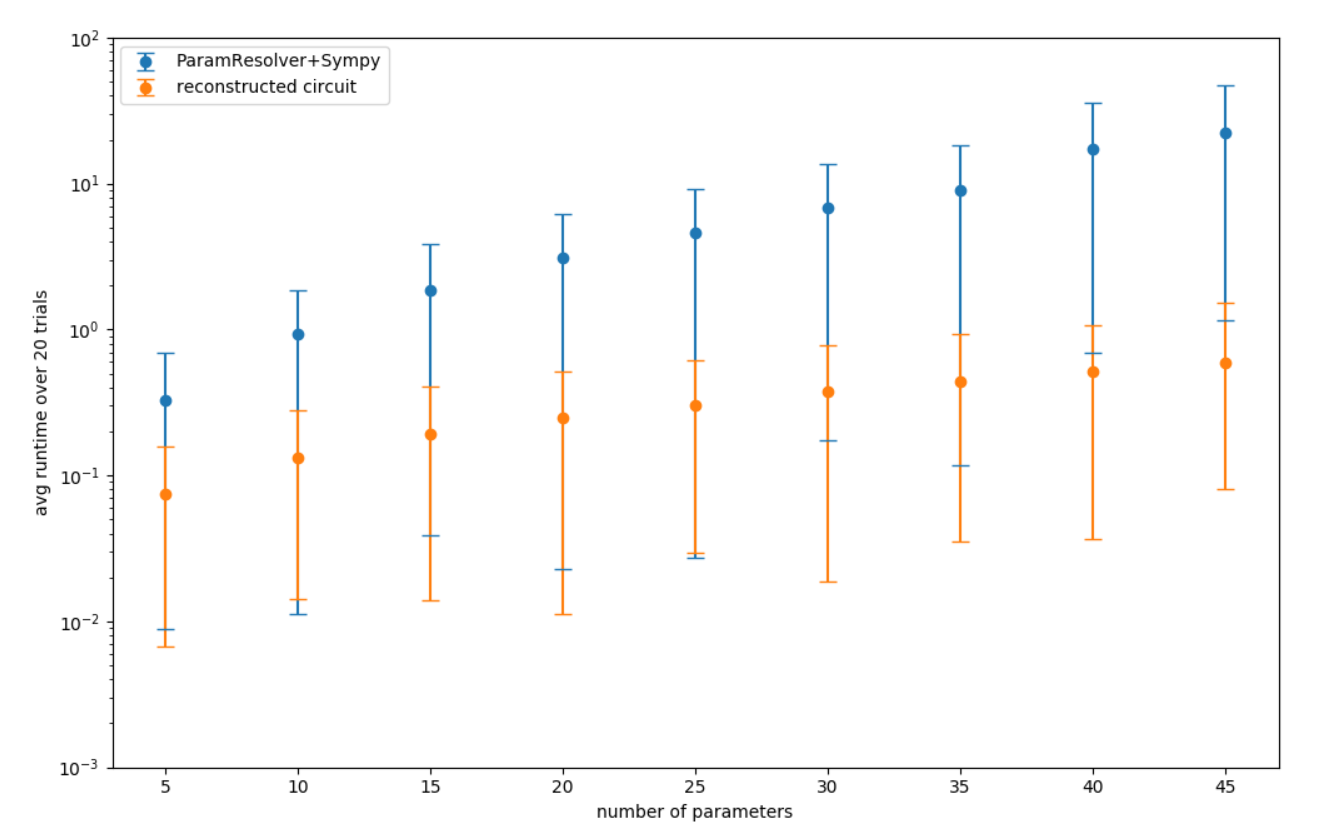ParamResolver is slow
See original GitHub issueReconstructing a circuit op-wise and replacing all parametrized ops with new ops containing parameter updates is 10-50x faster than using cirq.ParamResolver with sympy symbols…
Example code to reproduce:
from timeit import default_timer as timer
import numpy as np
import sympy
import cirq
def update_params(circuit, params):
"""Competitor method to cirq.ParamResolver."""
new_op_tree = []
for op, param in zip(circuit.all_operations(), params):
new_op_tree.append(op.gate._with_exponent(param/np.pi)(*op.qubits))
return cirq.Circuit.from_ops(new_op_tree)
trials = 100
for depth in [10, 15, 20]:
sympy_circuit = cirq.Circuit.from_ops([cirq.Rx(sympy.Symbol(str(k)))(cirq.LineQubit(0)) for k in range(depth)])
random_params = np.random.randn(trials, depth)
# time twenty runs
start = timer()
for j in range(trials):
resolver = dict(zip([str(k) for k in range(depth)], random_params[j]))
wf1 = cirq.Simulator().simulate(sympy_circuit, param_resolver=resolver).final_state
end = timer() - start
print(f"{depth} parameters, {trials} trials using Sympy+ParamResolver: {end} seconds")
start = timer()
for j in range(trials):
float_circuit = update_params(sympy_circuit, random_params[j])
wf2 = cirq.Simulator().simulate(float_circuit).final_state
end = timer() - start
print(f"{depth} parameters, {trials} trials using reconstructed circuit: {end} seconds")
produced (cirq v0.5.0, Windows 10 + core i7 gen 7 processor)
>>> 10 parameters, 100 trials using Sympy+ParamResolver: 2.408036000095308 seconds
>>> 10 parameters, 100 trials using reconstructed circuit: 0.1671589999459684 seconds
>>> 15 parameters, 100 trials using Sympy+ParamResolver: 4.347879000008106 seconds
>>> 15 parameters, 100 trials using reconstructed circuit: 0.25207799999043345 seconds
>>> 20 parameters, 100 trials using Sympy+ParamResolver: 7.1194350000005215 seconds
>>> 20 parameters, 100 trials using reconstructed circuit: 0.31734399998094887 seconds
Some plots of how this scales with large numbers of parameters (generated from a different script using the same update_params method):

Issue Analytics
- State:
- Created 4 years ago
- Reactions:1
- Comments:17 (1 by maintainers)
 Top Results From Across the Web
Top Results From Across the Web
cirq.ParamResolver - Google Quantum AI
Note that passing a formula to this resolver can be slow due to the underlying sympy library. For circuits relying on quick performance, ......
Read more >vavr-io/vavr - Gitter
First you start out with a ParamResolver (resolves a parameter), then switch it ... @danieldietrich how do I read those results? how much...
Read more >Query is slow when using parameters but fast when using literal
I have a query that runs against a pretty large table, I need to do a count on it. If I use a...
Read more >Service Management
The test suite does not run noticeably slower with this mechanism enabled. ... Parameter values are resolved later by Service or ParamResolver classes....
Read more >Source code for drf_yasg.openapi - drf-yasg - Read the Docs
... is EXTREMELY slow, replaced with plain raise raise AttributeError("object ... :type ref_or_obj: SwaggerDict or _Ref :param resolver: component resolver ...
Read more > Top Related Medium Post
Top Related Medium Post
No results found
 Top Related StackOverflow Question
Top Related StackOverflow Question
No results found
 Troubleshoot Live Code
Troubleshoot Live Code
Lightrun enables developers to add logs, metrics and snapshots to live code - no restarts or redeploys required.
Start Free Top Related Reddit Thread
Top Related Reddit Thread
No results found
 Top Related Hackernoon Post
Top Related Hackernoon Post
No results found
 Top Related Tweet
Top Related Tweet
No results found
 Top Related Dev.to Post
Top Related Dev.to Post
No results found
 Top Related Hashnode Post
Top Related Hashnode Post
No results found

I took a stab at short-circuiting sympy for common cases for PR #2394 . It does not help the above code as written, but, if flattened or if using XPowGate (which doesn’t add the “x/pi” formula), this speeds up the code significantly.
The changed code is below, for reference:
I modified the gate class to comply with Sympy:
but now I can not produce the circuit unitary:
I guess I have to first deal with this issue before getting at the issue of speed. Not sure here is the right place to focus on this issue?